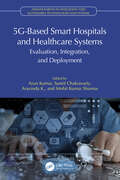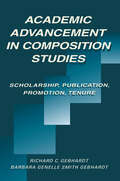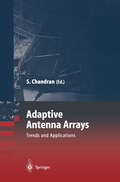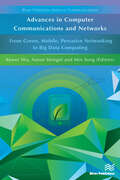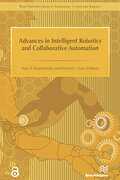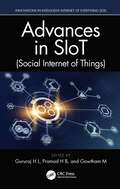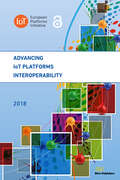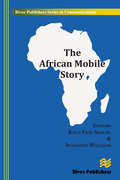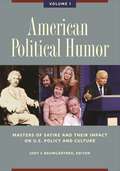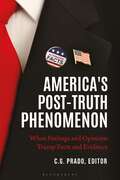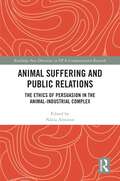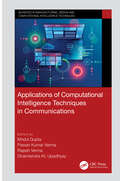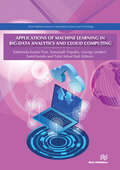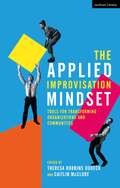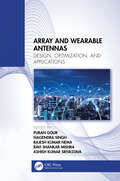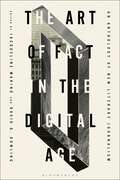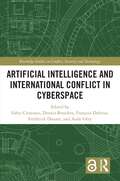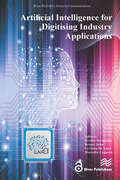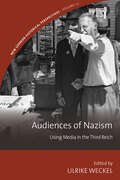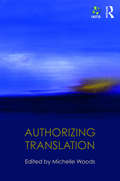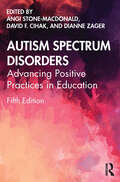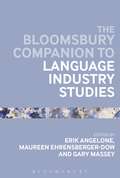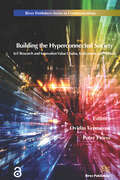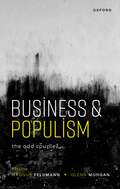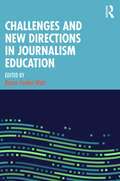- Table View
- List View
5G-Based Smart Hospitals and Healthcare Systems: Evaluation, Integration, and Deployment (Advancements in Intelligent and Sustainable Technologies and Systems)
With the increase in the development of the advanced cellular communication system, it is assumed that several sectors, such as the health industry, education, transport industry, business model, and so on, will rapidly grow. However, the requirements of the above-mentioned sectors are different and difficult to fulfill. Hence, 5G will be integral to several networks and will also need a unique management system for its successful rollout around the globe. 5G-Based Smart Hospitals and Healthcare Systems: Evaluation, Integration, and Deployment provides an overview of the role of advanced technologies in transforming the healthcare industry. It emphasizes the technical requirements of smart hospitals and the technologies associated with them along with explaining how technologies such as IoT, machine learning, and AI can be integrated with smart hospitals and 5G networks. The book evaluates several concerns such as privacy of data, infrastructure costs, and regular upgradability of technologies. Since the storage of information is a major concern with the implantation of 5G-based hospitals, this book will specifically address those issues along with examining the potential pitfalls of 5G-based hospitals and the factors that cause their failures. This book specifically targets professionals, academicians, engineers, researchers, management firms, technical institutes, R&D establishments, and individuals researching in the fields of 5G, healthcare, medical sensors, IoT, big data, and related fields. The main objectives of this book are to accumulate state-of-the-art IoT, 5G, AI, and machine learning-based approaches for resolving healthcare problems.
Academic Advancement in Composition Studies: Scholarship, Publication, Promotion, Tenure
This volume deals with a number of related issues that are becoming increasingly crucial for English studies during this time when most faculty in the field are assistant professors approaching tenure review or associate professors seeking promotion. These critical issues focus on: * The diversity of research and scholarly publication in composition studies; * The fact that composition studies faculty are often evaluated by personnel committee members, department chairs, and deans unfamiliar with the nature and demands of the field; * The way that American higher education is rethinking "scholarship" and the role it plays in the work and evaluation of faculty members; and * The role composition studies faculty can play in this review of scholarship and professional advancement. This book seeks to address the entire spectrum of "composition studies" -- expository and argumentative writing, personal essay, literary nonfiction, technical and business writing, historical rhetoric, empirical research, and more -- by understanding the nature of and evaluating the work of faculty members in this broad field. Scholarship and advancement issues are discussed in a variety of situations including basic and regular first-year composition classes at four-year and two-year institutions or writing centers, advanced writing courses, ESL and skills-development programs, and writing classes and programs for teachers, administrators, and researchers. The chapters focus on a variety of subjects, including the importance of mentoring and faculty development in all departments and institutions; and how young scholar-teachers and assistant professors can prepare for a successful personnel or tenure review.
Adaptive Antenna Arrays: Trends and Applications (Signals and Communication Technology)
This compilation of the works and insights of various key scientists and engineers in this area addresses the current and future trends of scenarios for employing adaptive antenna arrays in communication systems. Ideal as a quick reference for engineers, researchers, advanced undergraduate and postgraduate students.
Advances in Computer Communications and Networks From Green, Mobile, Pervasive Networking to Big Data Computing
Recent developments in computer communications and networks have enabled the deployment of exciting new areas such as Internet of Things and collaborative big data analysis. The design and implementation of energy efficient future generation communication and networking technologies also require the clever research and development of mobile, pervasive, and large-scale computing technologies. Advances in Computer Communications and Networks: from Green, Mobile, Pervasive Networking to Big Data Computing studies and presents recent advances in communication and networking technologies reflecting the state-of-the-art research achievements in novel communication technology and network optimization. Technical topics discussed in the book include: Data Center NetworksMobile Ad Hoc NetworksMultimedia NetworksInternet of ThingsWireless SpectrumNetwork Optimization.This book is ideal for personnel in computer communication and networking industries as well as academic staff and collegial, master, Ph.D. students in computer science, computer engineering, electrical engineering and telecommunication systems.
Advances in Intelligent Robotics and Collaborative Automation
This book provides an overview of a series of advanced research lines in robotics as well as of design and development methodologies for intelligent robots and their intelligent components. It represents a selection of extended versions of the best papers presented at the Seventh IEEE International Workshop on Intelligent Data Acquisition and Advanced Computing Systems: Technology and Applications IDAACS 2013 that were related to these topics. Its contents integrate state of the art computational intelligence based techniques for automatic robot control to novel distributed sensing and data integration methodologies that can be applied to intelligent robotics and automation systems. The objective of the text was to provide an overview of some of the problems in the field of robotic systems and intelligent automation and the approaches and techniques that relevant research groups within this area are employing to try to solve them.The contributions of the different authors have been grouped into four main sections:• Robots• Control and Intelligence• Sensing• Collaborative automationThe chapters have been structured to provide an easy to follow introduction to the topics that are addressed, including the most relevant references, so that anyone interested in this field can get started in the area.
Advances in SIoT (Innovations in Intelligent Internet of Everything (IoE))
The Social Internet of Things (SIoT) has become a hot topic in academic research. It employs the theory of social networks into the different levels of the Internet of Things (IoTs) and has brought new possibilities for the development of IoTs. Essentially, the SIoT is a subset of IoTs. It uses intelligent hardware and humans as the node, a social network as the organization type, the social relationship between things, things and humans, and between humans, formatting research methods and models with social network characteristics to realize the connection, service, and application of the IoTs. Moreover, SIoT is a form of realization of technology, architecture, and application of the IoTs using social network research methods. It further promotes the integration between real-world and virtual cyberspace, contributes the realization of the IoTs, expands the research scope of the social networking, and provides a new solution for the specific problems of the IoTs. Consequently, there is a tremendous need for researchers to have a comprehensive knowledge of the advances in SIoT. This special issue is soliciting scientific research papers that can present a snapshot of the latest research status of SIoT.
Advancing IoT Platforms Interoperability
The IoT European Platforms Initiative (IoT-EPI) projects are addressing the topic of Internet of Things and Platforms for Connected Smart Objects and aim to deliver an IoT extended into a web of platforms for connected devices and objects that supports smart environments, businesses, services and persons with dynamic and adaptive configuration capabilities. The specific areas of focus of the research activities are architectures and semantic interoperability, which reliably cover multiple use cases. The goal is to deliver dynamically-configured infrastructure and integration platforms for connected smart objects covering multiple technologies and multiple intelligent artefacts. The IoT-EPI ecosystem has been created with the objective of increasing the impact of the IoT-related European research and innovation, including seven European promising projects on IoT platforms: AGILE, BIG IoT, INTER-IoT, VICINITY, SymbIoTe, bIoTope, and TagItSmart.This white paper provides an insight regarding interoperability in the IoT platforms and ecosystems created and used by IoT-EPI. The scope of this document covers the interoperability aspects, challenges and approaches that cope with interoperability in the current existing IoT platforms and presents some insights regarding the future of interoperability in this context. It presents possible solutions, and a possible IoT interoperability platform architecture.
The African Mobile Story
Africa and especially Sub-Saharan Africa has during the past decade witnessed one of the fastest growing markets in mobile communication. This growth is recognized to have played a pivotal role in Africa’s socio-economic development. It has had a huge impact on residential living patterns; on business networks and models; and on government services and income sources. The mobile industry has contributed more to economic growth than in any other comparable region globally introducing innovative, broadly used applications. Technical topics discussed in the book include:• Mobile Development in Sub-Saharan Africa;• Telecom Liberalization in Africa;• Role of Mobile in Socio-economic Development;• Mobile Applications in specific sectors;• Security in African Mobile;• Role of Prepaid in Africa
American Political Humor [2 volumes]: Masters of Satire and Their Impact on U.S. Policy and Culture [2 volumes]
This two-volume set surveys the profound impact of political humor and satire on American culture and politics over the years, paying special attention to the explosion of political humor in today's wide-ranging and turbulent media environment.Historically, there has been a tendency to regard political satire and humor as a sideshow to the wider world of American politics—entertaining and sometimes insightful, but ultimately only of modest interest to students and others surveying the trajectory of American politics and culture. This set documents just how mistaken that assumption is. By examining political humor and satire throughout US history, these volumes not only illustrate how expressions of political satire and humor reflect changes in American attitudes about presidents, parties, and issues but also how satirists, comedians, cartoonists, and filmmakers have helped to shape popular attitudes about landmark historical events, major American institutions and movements, and the nation's political leaders and cultural giants. Finally, this work examines how today's brand of political humor may be more influential than ever before in shaping American attitudes about the nation in which we live.
America's Post-Truth Phenomenon: When Feelings and Opinions Trump Facts and Evidence
This book presents absorbing and critical expert perspectives on the post-truth phenomenon that has infiltrated the U.S. political system, media, and populace.Deception in politics is nothing new, but the quantity of unsubstantiated statements in America today is unprecedented. False notions, fake news, "alternative facts," and opinions are being pitched from sources including the White House, Congress, and the American population via Twitter, Facebook, and online news sites as well as print, television, and radio. Such a widespread spectacle instantly captures the attention of people nationwide, but disagreement has the nation almost bordering on civil war over the definition of "the truth" and what this book calls "post-truth."In this text, C.G. Prado and expert contributors present varied perspectives on post-truth, its authoritarian implications for the nation, and how we can approach information to differentiate between truth and post-truth. Speaking to general readers, students, and scholars alike, chapters include text on the historical and social events that initiated and developed post-truth and why some people are more prone than others to accept and perpetuate post-truth. They also discuss post-truth as a threat to democracy.
Animal Suffering and Public Relations: The Ethics of Persuasion in the Animal-Industrial Complex (Routledge New Directions in PR & Communication Research)
Animal Suffering and Public Relations conducts an ethical assessment of public relations, mainly persuasive communication and lobbying, as deployed by some of the main businesses involved in the animal-industrial complex—the industries participating in the systematic and institutionalised exploitation of animals.Society has been experiencing a growing ethical concern regarding humans’ (ab)use of other animals. This is a trend first promoted by the development of animal ethics—which claims any sentient being, because of sentience, deserves moral consideration—and more recently by other approaches from the social sciences, including critical animal studies. In this volume, we aim to start an entirely unaddressed discussion within the field of public relations: The need to problematise the ethics of persuasion when nonhuman animal suffering is involved, particularly the impact of persuasion and lobbying on compassion towards other animals in the cases of food, experimentation, entertainment, and environmental management. This book provides an interdisciplinary, theoretical discussion illustrated with international case studies from experts in strategic communication, public relations, lobbying and advocacy, animal ethics, philosophy of law, political philosophy, and social psychology.This unique book merges the fields of critical public relations, animal ethics, and critical animal studies and will be of direct appeal to a wide range of researchers, academics, and doctoral students across related fields.
Applications of Computational Intelligence Techniques in Communications (Advances in Manufacturing, Design and Computational Intelligence Techniques)
The book titled "Applications of Computational Intelligence Techniques in Communications" is a one-stop platform for the researchers, academicians, and people from industry to get a thorough understanding of the latest research in the field of communication engineering. Over the past decade, a manyfold increase in the use of computational intelligence techniques has been identified for obtaining the most optimal and timely solution to a problem. The various aspects covering the significant contribution of numerous computational intelligence techniques have been discussed in detail in this book. Today’s era of machine learning and Internet of Things (IoT) is demanding as high as possible data rate which has resulted into tremendous increased speed of communication. To match-up the pace, the computational intelligence is posing to be the most efficient and favourite tool. The book aims to cover the current technological advancements in the field of communication engineering and give a detailed prospect of computational intelligence to its readers. This book will be a great support to the people working in the field of IoT, machine learning, healthcare, optimization, filter design, 5G and beyond, signal processing etc. The chapters included here will expose its audience to various newly introduced and advanced computational intelligence techniques applicable in communication domain. The readers will be exposed multiple interdisciplinary areas of research in communication and will get the motivation to work in collaboration with other professionals from both the academia and industry.
Applications of Machine Learning in Big-Data Analytics and Cloud Computing
Cloud Computing and Big Data technologies have become the new descriptors of the digital age. The global amount of digital data has increased more than nine times in volume in just five years and by 2030 its volume may reach a staggering 65 trillion gigabytes. This explosion of data has led to opportunities and transformation in various areas such as healthcare, enterprises, industrial manufacturing and transportation. New Cloud Computing and Big Data tools endow researchers and analysts with novel techniques and opportunities to collect, manage and analyze the vast quantities of data. In Cloud and Big Data Analytics, the two areas of Swarm Intelligence and Deep Learning are a developing type of Machine Learning techniques that show enormous potential for solving complex business problems. Deep Learning enables computers to analyze large quantities of unstructured and binary data and to deduce relationships without requiring specific models or programming instructions.This book introduces the state-of-the-art trends and advances in the use of Machine Learning in Cloud and Big Data Analytics. The book will serve as a reference for Data Scientists, systems architects, developers, new researchers and graduate level students in Computer and Data science. The book will describe the concepts necessary to understand current Machine Learning issues, challenges and possible solutions as well as upcoming trends in Big Data Analytics.
The Applied Improvisation Mindset: Tools for Transforming Organizations and Communities
How can the practice of improvisation become the lens through which we view the world? The Applied Improvisation Mindset takes readers deep into the maturing field of Applied Improvisation (AI), with stories of 18 practitioners from five countries who embrace an improvisation mindset to create a more collaborative, equitable, sustainable, and joyous world. Myriad organizations have discovered how the mindset and skills applied by great improvisers onstage can reveal emergent, generative ways of interacting with others offstage.With case studies on developing presentation skills, reducing anxiety in teens, or preparing climate risk managers across the globe for the challenges ahead, this second volume serves as a valuable resource for both experienced and new AI facilitators. It is a primer for higher education and K-12 faculty combatting traditional teaching limitations and a practical “how to” for theatre practitioners, artists, educators, or anyone seeking to transform their organizations and communities.
Array and Wearable Antennas: Design, Optimization, and Applications
The text highlights the designing of efficient, wearable, and textile antennas for medical and wireless applications. It further discusses antenna design for the Internet of Things, biomedical, and 5G applications. The book presents machine learning and deep learning techniques for antenna design and analysis. It also covers radio frequency, micro-electromechanical systems, and nanoelectromechanical systems devices for smart antenna design.This book: Explores wearable reconfigurable antennas for wireless communication and provide the latest technique in term of its structure, defective ground plane, and fractal design Focuses on current and future technologies related to antenna design, and channel characterization for different communication links, and applications Discusses machine learning techniques for antenna design and analysis Demonstrates how nano patch antenna resonates at multiple frequencies by varying the chemical potential Covers the latest antenna technology for microwave sensors, and for fiber optical sensor communications It is primarily for senior undergraduate, graduate students, and academic researchers in the fields of electrical engineering, electronics and communications engineering.
The Art of Fact in the Digital Age: An Anthology of New Literary Journalism
The Art of Fact in the Digital Age is a showcase of the most powerful and moving journalism of the past 25 years. Selections include stories originally published in established bastions of literary journalism (The New York Times, The Atlantic and The New Yorker), as well as those from specialized and online publications (Runner's World, The Atavist). It features writers of extraordinary style (including Carina del Valle Schorske, Brian Phillips, and Jia Tolentino), as well as those who have profoundly influenced public discourse on the 21st century's most urgent issues: Mitchell S. Jackson, Clint Smith, and Ta-Nehisi Coates on race; Susan Dominus and Luke Mogelson on migration; and Kathryn Schulz and David Wallace-Wells on environmental threats. It even includes one story that expanded literary journalism's repertoire into audio (This American Life). This collection, assembled for students, scholars, and practitioners alike, also charts the evolution of digital longform journalism through its greatest achievements, from transitioning readers to screens to the integration of multimedia with words in service of meaning. The art of fact in the 21st century opened new ranges of expression to address such issues, while uniquely bearing the imprint of their generation's digital cultures and technologies. Although many forces compete for attention in the digital age, story triumphs. The works in this anthology show us why.
Artificial Intelligence and International Conflict in Cyberspace (Routledge Studies in Conflict, Security and Technology)
This edited volume explores how artificial intelligence (AI) is transforming international conflict in cyberspace. Over the past three decades, cyberspace developed into a crucial frontier and issue of international conflict. However, scholarly work on the relationship between AI and conflict in cyberspace has been produced along somewhat rigid disciplinary boundaries and an even more rigid sociotechnical divide – wherein technical and social scholarship are seldomly brought into a conversation. This is the first volume to address these themes through a comprehensive and cross-disciplinary approach. With the intent of exploring the question ‘what is at stake with the use of automation in international conflict in cyberspace through AI?’, the chapters in the volume focus on three broad themes, namely: (1) technical and operational, (2) strategic and geopolitical, and (3) normative and legal. These also constitute the three parts in which the chapters of this volume are organised, although these thematic sections should not be considered as an analytical or a disciplinary demarcation. This book will be of much interest to students of cyber-conflict, artificial intelligence, security studies and International Relations.
Artificial Intelligence for Digitising Industry – Applications
This book provides in-depth insights into use cases implementing artificial intelligence (AI) applications at the edge. It covers new ideas, concepts, research, and innovation to enable the development and deployment of AI, the industrial internet of things (IIoT), edge computing, and digital twin technologies in industrial environments. The work is based on the research results and activities of the AI4DI project, including an overview of industrial use cases, research, technological innovation, validation, and deployment. This book’s sections build on the research, development, and innovative ideas elaborated for applications in five industries: automotive, semiconductor, industrial machinery, food and beverage, and transportation. The articles included under each of these five industrial sectors discuss AI-based methods, techniques, models, algorithms, and supporting technologies, such as IIoT, edge computing, digital twins, collaborative robots, silicon-born AI circuit concepts, neuromorphic architectures, and augmented intelligence, that are anticipating the development of Industry 5.0. Automotive applications cover use cases addressing AI-based solutions for inbound logistics and assembly process optimisation, autonomous reconfigurable battery systems, virtual AI training platforms for robot learning, autonomous mobile robotic agents, and predictive maintenance for machines on the level of a digital twin. AI-based technologies and applications in the semiconductor manufacturing industry address use cases related to AI-based failure modes and effects analysis assistants, neural networks for predicting critical 3D dimensions in MEMS inertial sensors, machine vision systems developed in the wafer inspection production line, semiconductor wafer fault classifications, automatic inspection of scanning electron microscope cross-section images for technology verification, anomaly detection on wire bond process trace data, and optical inspection. The use cases presented for machinery and industrial equipment industry applications cover topics related to wood machinery, with the perception of the surrounding environment and intelligent robot applications. AI, IIoT, and robotics solutions are highlighted for the food and beverage industry, presenting use cases addressing novel AI-based environmental monitoring; autonomous environment-aware, quality control systems for Champagne production; and production process optimisation and predictive maintenance for soybeans manufacturing. For the transportation sector, the use cases presented cover the mobility-as-a-service development of AI-based fleet management for supporting multimodal transport. This book highlights the significant technological challenges that AI application developments in industrial sectors are facing, presenting several research challenges and open issues that should guide future development for evolution towards an environment-friendly Industry 5.0. The challenges presented for AI-based applications in industrial environments include issues related to complexity, multidisciplinary and heterogeneity, convergence of AI with other technologies, energy consumption and efficiency, knowledge acquisition, reasoning with limited data, fusion of heterogeneous data, availability of reliable data sets, verification, validation, and testing for decision-making processes.
Audiences of Nazism: Using Media in the Third Reich (New German Historical Perspectives #13)
Through its focus on audiences and their reception of media in Nazi Germany, Audiences of Nazism inverts the typical top-down perspective employed in studies that concentrate on the regime’s regulation of media and propaganda. It thereby sheds new light on the complex character of the period’s media, their uses, and the scope for audience interpretation. Contributors investigate how consumers either appropriated or ignored certain messages of Nazi propaganda, and how some even participated in its production. The authors ground their studies on novel historical sources, including private diaries and letters, photographs and films, and concert programs, which demonstrate, amongst other things, how audiences interpreted and responded to regulated news, Nazi Party rallies, and the regime’s denunciation of modern works of art as ‘degenerate.’
Authorizing Translation: The IATIS Yearbook (The IATIS Yearbook)
Authorizing Translation applies ground-breaking research on literary translation to examine the intersection between Translation Studies and literary criticism, rethinking ways in which analyzing translation and the authority of the translator can provide nuanced micro and macro readings of literary work and the worlds through which it moves. A substantial introduction surveys the field and suggests possible avenues for future research, while six case-study-based chapters by a new generation of Literature and Translation Studies scholars focus on the question of authority by asking: Who authors translations? Who authorizes translations? What authority do translations have in different cultural contexts? What authority does Literary Translation Studies have as a field? The hermeneutic role of the translator is explored through the literary periods of Romanticism, Modernism, and Postmodernism, and through different cultures and languages. The case studies focus on data-centered analysis of reviews of translated literature, ultimately illustrating how the translator’s authority creates and hybridizes literary cultures. Authorizing Translation will be of interest to students and researchers of Literary Translation and Translation Studies. Additional resources for Translation and Interpreting Studies are available on the Routledge Translation Studies Portal: http://cw.routledge.com/textbooks/translationstudies.
Autism Spectrum Disorders: Advancing Positive Practices in Education
The fifth edition of Autism Spectrum Disorders: Advancing Positive Practices in Education provides readers with a comprehensive and accessible understanding of current research and evidence-based practices in autism spectrum disorders (ASD), linking research, theory, and practice. This new edition includes new chapters on trauma and co-morbidity, current trends in autism research, social media, neurodiversity, and aging in people with ASD. It also features updated content on international contexts and culturally sustaining and relevant practices. Aligned with DSM-5 diagnostic criteria, this text continues to be critical reading for students and researchers in special and inclusive education programs.
The Bloomsbury Companion to Language Industry Studies (Bloomsbury Companions)
This volume provides a comprehensive overview of the key issues shaping the language industry, including translation, interpreting, machine translation, editing, terminology management, technology and accessibility. By exploring current and future research topics and methods, the Companion addresses language industry stakeholders, researchers, trainers and working professionals who are keen to know more about the dynamics of the language industry. Providing systematic coverage of a diverse range of translation and interpreting related topics and featuring an A to Z of key terms, The Bloomsbury Companion to Language Industry Studies examines how industry trends and technological advancement can optimize best practices in multilingual communication, language industry workspaces and training.
Building the Hyperconnected Society- Internet of Things Research and Innovation Value Chains, Ecosystems and Markets
This book aims to provide a broad overview of various topics of Internet of Things (IoT), ranging from research, innovation and development priorities to enabling technologies, nanoelectronics, cyber-physical systems, architecture, interoperability and industrial applications. All this is happening in a global context, building towards intelligent, interconnected decision making as an essential driver for new growth and co-competition across a wider set of markets. It is intended to be a standalone book in a series that covers the Internet of Things activities of the IERC – Internet of Things European Research Cluster from research to technological innovation, validation and deployment.The book builds on the ideas put forward by the European Research Cluster on the Internet of Things Strategic Research and Innovation Agenda, and presents global views and state of the art results on the challenges facing the research, innovation, development and deployment of IoT in future years. The concept of IoT could disrupt consumer and industrial product markets generating new revenues and serving as a growth driver for semiconductor, networking equipment, and service provider end-markets globally. This will create new application and product end-markets, change the value chain of companies that creates the IoT technology and deploy it in various end sectors, while impacting the business models of semiconductor, software, device, communication and service provider stakeholders. The proliferation of intelligent devices at the edge of the network with the introduction of embedded software and app-driven hardware into manufactured devices, and the ability, through embedded software/hardware developments, to monetize those device functions and features by offering novel solutions, could generate completely new types of revenue streams. Intelligent and IoT devices leverage software, software licensing, entitlement management, and Internet connectivity in ways that address many of the societal challenges that we will face in the next decade.
Business and Populism: The Odd Couple?
Business and Populism analyses the relationship between right wing populism and business with a focus on business responses and strategies in the face of the global populist turn. In the neoliberal era business had become accustomed to favourable economic policy regimes and governance arrangements that facilitated business influence on key policy issues. The rise of populist movements in various parts of the world is widely perceived as a significant challenge to policymaking, mainstream political parties and even to liberal democracy. Yet we know very little about the impact of populism on business, beyond the fact that the anti-elite challenge of populism frequently targets business with policies to restrict globalization, outsourcing, and labour migration whilst at the same time embracing capitalism, low taxes, and deregulated markets. Populists also glory in presenting themselves as authentic representatives of the people, symbolizing this in their demotic language, their rejection of standards of 'polite' society and liberal 'woke' values, including attacking core intermediary institutions such as independent central banks, the judiciary, the civil service, universities and expert knowledge, and a free press central to post-1945 versions of liberal democracy. When faced with these disruptions and the risks they pose for business, how does business respond? Does it choose to support or challenge populists in different countries? This volume advances the debate by providing empirical studies of the impact of right-wing populism on business. Finally, it considers whether populism will continue to be influential and how its success might impact on business strategy and structure.
Challenges and New Directions in Journalism Education
Drawing on original and innovative contributions from educators, practitioners and students, Challenges and New Directions in Journalism Education captures and informs our understanding of journalism pedagogy in the context of ongoing shifts in journalism practice. Journalism is once again facing challenges, accused of elitism and often branded as too far removed from the reality of people’s lives. The post-truth context has engendered a crisis of trust, and journalism is portrayed as core to the problem, rather than the solution. Citizen journalism and societal shifts have provoked a move away from ‘top-down’ reporting, towards greater interactivity with audiences, but inclusivity remains an issue with news organisations and industry councils intensifying protocols in a bid to create more diverse newsrooms. This poses multiple questions for journalism educators: How is journalism education engaging with these imperatives in the ‘post-pandemic’ context? How can student perspectives inform our response? What journalism should we teach? Against this landscape, and in response to these questions, this book engages with a series of key themes and objectives related to challenges and new directions in journalism education. These include discussions around safeguarding, sustainability, journalism’s ‘democratic deficit’, integrating media literacy and the ‘post-pandemic’ context. Each chapter draws on primary data, case studies and examples to describe and unpack the topic, and concludes with practical suggestions for journalism educators. Challenges and New Directions in Journalism Education is key reading for anyone teaching or training to become a teacher of journalism.
